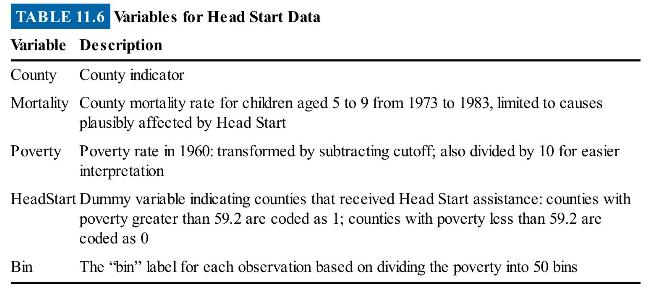Ludwig and Miller (2007) used a discontinuity in program funding for Head Start to test the impacts
Question:
Ludwig and Miller (2007) used a discontinuity in program funding for Head Start to test the impacts on child mortality rates. In the 1960s, the federal government helped 300 of the poorest counties in the United States write grants for Head Start programs. Only counties where poverty was greater than 59.2 percent received this assistance. This problem explores the effects of Head Start on child mortality rates. Table 11.6 lists the variables.
(a) Write out an equation for a basic RD design to assess the effect of Head Start assistance on child mortality rates. Draw a picture of what you expect the relationship to look like. Note that in this example, treatment occurs for low values of the assignment variable.
(b) Explain how RD analysis can identify a causal effect of Head Start assistance on mortality.
(c) Estimate the effect of Head Start on mortality rate by using a basic \(\mathrm{RD}\) design.
(d) Estimate the effect of Head Start on mortality rate by using a varying slopes \(\mathrm{RD}\) design.
(e) Estimate a basic RD model with (adjusted) poverty values that are between -0.8 and 0.8 . Comment on your findings.
(f) Implement a quadratic \(\mathrm{RD}\) design. Comment on the results.
(g) Create a scatterplot of the mortality and poverty data. What do you see?
(h) Use the following code to create a binned graph of the mortality and poverty data. What do you see? 
(i) Rerun the quadratic model, and save predicted values as FittedQuadratic. Include the fitted values in the graph from part
(h) by adding (scatter FittedQuadratic Poverty) to the code above. Explain the results.

Step by Step Answer:

Real Econometrics The Right Tools To Answer Important Questions
ISBN: 9780190857462
2nd Edition
Authors: Michael Bailey





